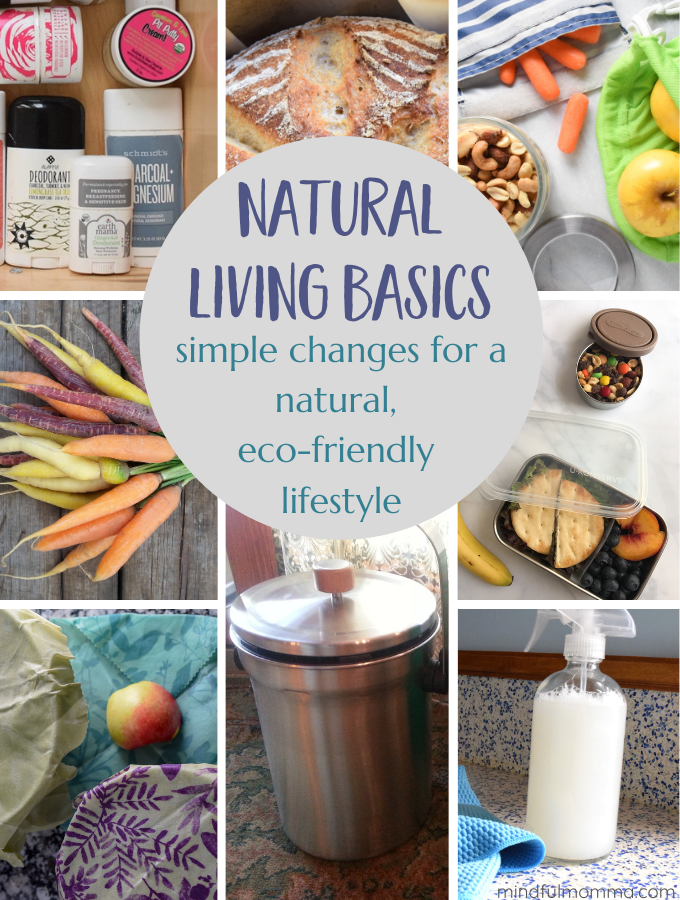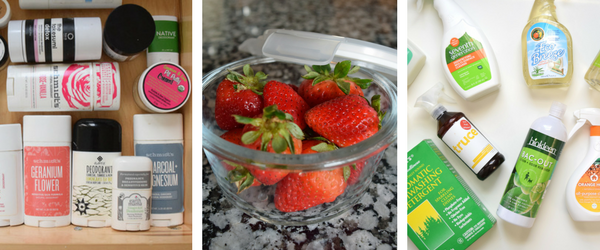Natural Living Changes for a Healthy Home & Eco-Friendly Lifestyle
Learn about natural living and the types of changes to make for a healthy home and an eco-friendly and natural lifestyle.

Organic. Sustainable. Non-Toxic. If you are in search of a definition of natural living you will find many different opinions, depending on who you ask or which corner of the Internet you search in.
Trying to understand exactly what natural living means can be quite confusing and even intimidating, but I’d much rather have it be inspiring!
So let’s take a look at some of the ideas behind natural living and I’ll show you some small changes you can make to live a more natural, healthy lifestyle. After that, you get to pick and choose what works for you and your family. Sound good? Let’s dive in!
At Mindful Momma we only endorse products we’ve personally researched, tested, and honestly love. We may receive commissions from affiliate links in this article including Amazon Affiliates. Full Disclosure
Tips for Creating a Natural Lifestyle
One of the basic principles behind natural living is to use and eat things the way they are found in nature. In today’s world we’ve come a long way away from using things in their natural state – think of all the products made from plastic and other man-made, chemical-based compounds, and all the factory produced and processed food we eat.
It’s not all bad – I can’t imagine life without my trusty computer or my favorite corn chips! Yet we could definitely benefit from reducing our reliance on processed and manufactured products and getting back to things that are made by hand from natural materials.
Another important principle of natural living is connecting with nature and taking steps to take care of our natural world. As we live our busy lives, it’s easy to forget about things like climate change or even how wonderful it feels to take a walk in the woods. It’s also easy to forget all the little things we can do every day to protect our planet.
Let’s explore those natural lifestyle ideas a little further!
Natural Living Changes You Can Make
Take a few minutes to think about your daily routine – all the products you use, the food you eat, how much waste you produce, how much time you spend outside. No matter how crunchy you already are, I bet there are a few changes you can make to embrace a natural, non-toxic lifestyle and do your part for the environment too. Following these eco-friendly ideas will make you a more conscious consumer.

1. Focus on Real Food
“If the label says natural does that mean it’s healthy?”
“Do fruit snacks really count as a serving of fruit?”
“Does all my food have to be organic?”
These are common questions I’ve heard over the years. Feeding our families healthy, real food can be challenging given the demands on our time and money, plus all the greenwashing and confusing information out there.
Here are a few things you can do to navigate the grocery store and get set up to eat well and as naturally as possible:
- Stock up on whole, unprocessed foods such as vegetables, fruits, beans, grains, nuts and minimally processed foods like meat, seafood and dairy
- Shop the perimeter of the grocery store and stay out of the aisles full of junk food
- Buy organic as often as possible – use the EWG’s Dirty Dozen and your budget as a guide
- Read labels and avoid the worst preservatives and food additives
- Use these tips for eating healthy on a budget
- If you eat some processed foods, look for options made with a small number of real food ingredients (like a Lara bar for instance)
- Join Thrive Market for low prices on healthy, natural and organic foods. (Get an additional 25% off your first order when you use my link.)
- Shop at farmer’s markets or purchase a CSA share
- Cook your own meals and teach your kids to help
- Make homemade versions of common packaged foods like cookies, oatmeal and spice mixes
This doesn’t mean there is no room for occasional junky treats and convenience foods. If there’s one thing I’ve learned about being a more mindful grocery shopper is that it’s all about balance!

2. Switch to Natural, Non-Toxic Products
The biggest problem with all the manufactured and processed products that we use in our lives every day is that they are made with chemicals that can harm both humans and the environment. I’ve written a whole post about the reasons to buy natural, non-toxic products so be sure to check it out!
Here are some swaps you can make to replace toxic products with safe products made from natural materials:
- Household products like food storage containers, bottles, cutting boards etc…made from glass, wood and metal instead of plastic
- Non-toxic cookware made from cast iron, stainless steel or ceramic instead of toxic non-stick
- Clothing, bed linens and table linens made from organic cotton, bamboo, wool and other natural fibers instead of polyester and chemical-infused fabrics
- Personal care and beauty products like shampoo, deodorant and makeup made without parabens, sulfates, artificial fragrances and other harmful chemicals
- Cleaning products including laundry and household cleaners made with safe, eco-friendly ingredients
- Furniture, mattresses and floor coverings produced without harmful flame retardants, formaldehyde or other off-gassing chemicals
- Use natural health remedies instead of drugs (always consult with your doctor first)
- Thrive Market is a great resource for natural, non-toxic products at low prices – ranging from beauty to cleaning to products for the home.
- DIY – make your own homemade cleaning products and DIY beauty products

3. Make Mindful, Eco-Friendly Choices
Most of us have grown up in a culture of abundance. We have all the food we can possibly eat, all the water we care to pour, all the heat we need to stay toasty warm. We are incredibly lucky, but the downside is that we tend to be wasteful. We leave the water running when we brush our teeth. We throw perfectly good food in the garbage. We buy clothing we do not need. This culture of excess is bad for the planet.
It’s time to reexamine our habits and look for ways to conserve resources, create less waste and take care of this precious planet we live on. In my book, Practically Green: Your Guide to EcoFriendly Decision-Making, I have a whole chapter dedicated to conserving, which goes into more detail but meanwhile….
Here are some easy changes you can make to lower your impact on the planet:
- Switch to reusable products instead of disposable (the kitchen and laundry are a great place to start!)
- Conserve water (turn off the tap, use low-flow shower heads and toilets, use a soaker hose in the garden)
- Manage home energy use with a programmable thermostat, timers on lights, weather-stripping and more
- Buy used – shop thrift stores and garage sales or online at Craigslist or local websites
- Repurpose – turn spaghetti sauce jars or yogurt tubs into storage containers, use old t-shirts for rags
- Do without – ask yourself “Do I really need it?” and read my tips for how to buy less and feel great about it
- Grow some of your own food – whether it’s a garden full of vegetables or a couple pots of herbs in containers
- Compost food scraps to create healthy soil for your garden
- Create less waste – read my tips for easy ways to reduce waste at home and some zero waste kitchen ideas
- Recycle everything you can (use earth911.com to find out where to recycle unusual items)
- Buy in bulk and refill containers to reduce packaging
- Shop local or from small socially responsible businesses
- Eat seasonally and locally to reduce transportation and storage costs
- Walk or bike instead of driving everywhere – get outside and enjoy nature!
Whatever definition of natural living strikes a chord with you, I hope this has helped you find a few new ways to shift your habits and lifestyle to be a bit more natural and earth-friendly! Be sure to bookmark or PIN this post to reference later – there are a ton of helpful links in here!
What does natural living mean to you? What are some changes you hope to make in your lifestyle?




I love these changes! This blog definitely proves that it does not take a lot to make a collective change but just a lot of little things can come together to help!
Thank you so much for sharing xx
So glad you find it helpful!
I’m very excited about the grocery shopping area of this article, that’s the scariest area for me.Thanks for sharing.
Great changes are the key. Making a change that won’t last takes getting used to. But they are worth it to ourselves and our children. If we teach our children how to live naturally, we have made the world a little bit better. And each little bit adds up… It isn’t “How we leave Our World to our Children, but, What kind of Children will we leave to Our WORLD.”. They can make the changes if taught the Right ways. It’s up to us to ensure they are taught the Right Way. LOVE this Site….
Love that perspective about making sure our children will take care of the planet too! So important!
Great primer on natural living! So many things to do!
Thank you Olive!
I’ve been working to lessen the amount of waste we produce (just me and my hubby), last week we had a half a small garbage bag for the week and our recycling bin wasn’t very full, which made me feel good! Still a work in progress but making small changes a little at a time isn’t as overwhelming. Next step is to try making my own cleaning products and beauty products because I recycle a lot of packaging that I’d like to eliminate, plus it would make me feel like I’m treating my body and home better (though I already switched to healthier brands a while ago, DIY will always be the best I think).
Love hearing about all the good changes you’ve made Ashley! It’s true – doing DIY for cleaning and beauty products can eliminate a lot of packaging! I save glass jars from beauty products and reuse them for my DIY’s. I also save spray bottle from cleaning products to make my own. Keep up the good work!
I’m very excited for the grocery shopping area of this article, that’s the scariest area for me.
Last year I made a switch to cruelty free beauty/hygiene products..a lot of them are eco friendly etc, and that’s how i got to my 2020 goal of a more eco friendly lifestyle.
I took a quiz online on ThredUp and found that my fashion carbon print is 80% lower than the average person’s, mostly because I thrift shop and donate/sell my old clothes..so I feel those 2 areas are under control.
I’ve recently made the swap to metal straws, glass storage containers and reusable dryer balls..baby steps w the home as I’m learning..
Love this Kala! Sounds like you’ve already done a lot and are on a great path to your goal! Keep it up!
Great tips and balance.
Thanks! Would love to know what types of changes you are looking to make!
Thank you for the lovely run-down above. I am currently working on a Land-Arts project with all items being from the park itself, and anything else used must be biodegradable. I’m having trouble with the following items and would love any resource to research:
1. Watercolor paint- clear of heavy metals for coloring and toxic-free
2. Sidewalk chalk-clear of lead and as “clean” as possible
3; I’m using a wheat and water glue-another ideas?
Thank you.
SK
Here’s a post that covers non-toxic art supplies. Hope you can find a few helpful things here: https://mindfulmomma.com/non-toxic-art-supplies/
I love how your blog emphasizes both human well-being and environmental health. This article reminded me that living eco-consciously is a great step toward a better life. Sometimes, I forget about how wonderful it feels to take a walk in the woods or simply enjoy the feeling of the breeze. It’s comforting to know that mindful living is achievable for everyone, as long as we’re willing to achieve it. Thank you for sharing such valuable information and tips on natural living!
Glad you find it helpful!
I love shopping at the local co-op. They have organic produce from local farms with zero packaging. It feels incredible not to throw away endless plastic when getting fresh veggies that aren’t wrapped for space travel.
I found a local soap maker that uses the best ingredients and has no palm oil. It’s not as complicated as it seems to make a difference.